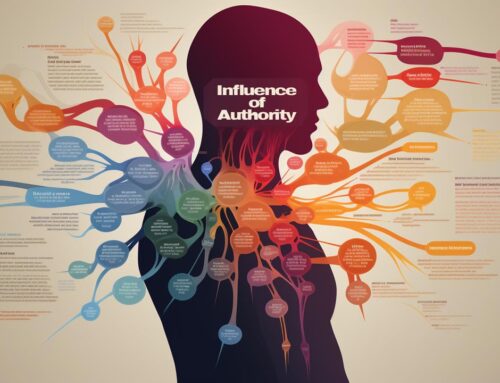If you’d like to start this series from the beginning, start with The Power of Persuasion Part 1
The Power of Persuasion Part 7. The Neurological Basis of Influence
The neurological basis of influence delves into the fascinating field of neuroscience to understand how the human brain responds to various influential factors. By exploring the brain’s mechanisms, scientists and researchers gain valuable insights into why and how individuals are influenced by different stimuli, such as persuasive messages, social cues, and emotional appeals. Understanding the neurological basis of influence is essential in fields like marketing, communication, and leadership, as it provides a scientific foundation for crafting effective strategies. Let’s explore each aspect in detail:
Table of Contents
- Introduction to the Neurological Basis of Influence
- Neuroplasticity and Brain Adaptation
- The Role of Neurotransmitters in Influence
- Emotional Influence and the Limbic System
- The Role of Mirror Neurons in Social Influence
- Cognitive Biases and Influence
- Neuromarketing and Consumer Behavior
- Neurological Basis of Persuasive Communication
- The Influence of Social Context on the Brain
- Ethical Considerations in Neuromarketing and Influence
- Applications of the Neurological Basis of Influence
- The Future of Neuroscientific Influence
- Case Studies
- Top 10 Frequently Asked Questions
- Final Thoughts
- Sources
Introduction to the Neurological Basis of Influence
The neurological basis of influence examines how the human brain processes and responds to persuasive communication. This field bridges neuroscience and psychology, exploring how various brain mechanisms, from cognitive functions to emotional responses, underpin our susceptibility to influence and persuasion. Understanding these neurological underpinnings is crucial for comprehending why certain persuasive techniques are effective and how messages can be crafted to resonate more deeply with individuals.
At the core of this concept is the interplay between emotion and logic within the brain. While traditional views of persuasion emphasized logical reasoning and argumentation, contemporary research highlights the significant role of emotions in decision-making processes. Neurological studies have shown that emotional appeals often bypass cognitive processing to elicit more immediate and compelling responses. This intersection of emotion and rationality is central to understanding the effectiveness of various influence strategies, from advertising and political rhetoric to everyday interpersonal interactions.
By delving into the brain’s response to different stimuli, researchers can ascertain how factors like trust, authority, social norms, and personal experiences shape our attitudes and behaviors. This knowledge not only enriches our understanding of human psychology but also holds practical applications in fields such as marketing, education, leadership, and public relations.
Neuroplasticity and Brain Adaptation
Neuroplasticity refers to the brain’s ability to change and adapt as a result of experience. This concept is pivotal in understanding how exposure to various forms of media and advertising can influence thought patterns, behaviors, and even belief systems over time.
- Adaptation to Stimuli: The brain’s structure and function can change in response to repeated exposure to certain stimuli, including persuasive messages. This adaptability means that regular exposure to specific types of content can shape neural pathways, potentially influencing long-term preferences and decisions.
- Learning and Habit Formation: Neuroplasticity is fundamental in learning and habit formation. As individuals are repeatedly exposed to certain persuasive techniques or messages, their brains adapt, making them more receptive to similar content in the future.
- Resilience and Counteracting Influence: On the positive side, understanding neuroplasticity allows for strategies to counteract unwanted influences. Just as the brain can be conditioned to respond to certain types of persuasion, it can also be trained to resist them, enhancing critical thinking and media literacy skills.
Neuroplasticity underscores the long-term impact of media and advertising on individual cognition and behavior. It highlights the importance of responsible media consumption and the need for ethical standards in content creation and advertising.
The Role of Neurotransmitters in Influence
Neurotransmitters play a significant role in how the brain processes and reacts to persuasive messages. These chemical messengers facilitate communication between neurons and influence a wide range of psychological functions, from emotional responses to cognitive processing.
- Dopamine and Reward Pathways: Dopamine is often associated with the brain’s reward system. Persuasive messages that align with an individual’s desires or that are particularly satisfying can trigger dopamine release, creating feelings of pleasure and reinforcing certain behaviors and attitudes.
- Serotonin and Social Behaviors: Serotonin impacts mood, social behavior, and decision-making. Lower levels of serotonin are associated with increased susceptibility to persuasion, possibly due to a greater need for social acceptance.
- Oxytocin and Trust: Known as the ‘trust hormone,’ oxytocin influences social bonding and trust. Persuasive messages delivered by sources perceived as trustworthy or within a trusted community can be more effective due to the influence of oxytocin.
Understanding the role of these neurotransmitters can provide insights into why certain persuasive strategies resonate more effectively and how repeated exposure to specific types of content can lead to behavioral changes.
Emotional Influence and the Limbic System
The limbic system, a complex set of structures in the brain, plays a crucial role in processing and regulating emotions. Its function is deeply intertwined with how individuals respond to persuasive communications.
- The Amygdala and Fear Responses: The amygdala is key in processing emotions like fear and pleasure. Advertising that elicits emotional responses, particularly fear or safety concerns, can be highly persuasive due to the amygdala’s influence on emotional processing and memory.
- The Prefrontal Cortex and Decision-Making: While not part of the limbic system, the prefrontal cortex is crucial in decision-making and moderates social behavior. It works in conjunction with the limbic system to balance emotional responses with rational thought, playing a vital role in how we evaluate persuasive messages.
- The Hippocampus and Memory: The hippocampus is essential for forming new memories. Emotional advertising can be more memorable and impactful, as the hippocampus links emotions to specific information, leading to stronger recall.
Understanding the limbic system’s role in emotional processing helps to explain why emotionally charged content can be more engaging and influential, guiding strategies in advertising and political campaigns to create more impactful messages.
The Role of Mirror Neurons in Social Influence
Mirror neurons are a type of brain cell that respond equally when an individual performs an action and when they observe someone else performing the same action. These neurons play a significant role in understanding others’ actions and intentions, influencing social behaviors and empathy.
- Imitation and Empathy in Persuasion: Mirror neurons facilitate the understanding and imitation of others’ behaviors and emotions. In the context of persuasion, this neurological mirroring can lead individuals to empathize with and emulate the attitudes or behaviors presented in media or advertising.
- The Neuroscience of Connection and Understanding: The activation of mirror neurons can create a sense of connection and relatability with on-screen characters or spokespersons, making persuasive messages more effective.
The understanding of mirror neurons provides valuable insights into social learning and the power of demonstration in persuasive communication, highlighting why testimonials, endorsements, and relatable storytelling can be potent tools in influencing attitudes and behaviors.
Cognitive Biases and Influence
Cognitive biases are systematic patterns of deviation from rational judgment, deeply rooted in human cognition. These biases significantly impact how individuals process information and make decisions, often influencing their susceptibility to persuasive messages.
- Confirmation Bias: This bias leads individuals to favor information that confirms their pre-existing beliefs. Persuasive messages that align with the audience’s existing attitudes are more likely to be accepted and reinforced.
- Availability Heuristic: This involves making decisions based on the information readily available or recent in memory. Media and advertising can exploit this bias by emphasizing certain information or events to shape public opinion.
- Anchoring Bias: In decision-making, individuals often rely heavily on the first piece of information offered (the “anchor”). Advertisers use anchoring to set a context or baseline from which consumers evaluate subsequent information.
Understanding these biases allows for the development of more effective persuasive strategies that align with natural cognitive tendencies while also highlighting the importance of ethical considerations in using these psychological insights.
Neuromarketing and Consumer Behavior
Neuromarketing is a field that applies neuroscience to marketing research, seeking to understand how consumers respond to marketing stimuli.
- Neural Responses to Advertisements: By using brain-imaging and physiological tracking tools, neuromarketers can observe the brain’s response to advertisements. This includes measuring attention, emotion, and memory, which are critical in predicting consumer behavior.
- Neuroimaging Techniques in Marketing Research: Techniques like fMRI (functional Magnetic Resonance Imaging) and EEG (Electroencephalography) allow researchers to see how different areas of the brain react to marketing stimuli, giving insights into what captures attention, generates interest, and persuades consumers.
Neuromarketing helps businesses understand the subconscious drivers of consumer behavior, allowing for more effective marketing strategies. However, it also raises ethical questions about the manipulation of consumer choices.
Neurological Basis of Persuasive Communication
The neuroscience of persuasive communication focuses on understanding how the brain processes and reacts to persuasive messages.
- Storytelling and Neural Synchronization: Storytelling can lead to a phenomenon known as neural synchronization, where the listener’s brain mirrors the storyteller’s activity. This synchronization can enhance empathy and understanding, making storytelling a powerful persuasive tool.
- Appeals to Emotion and Memory Formation: Emotional content can trigger stronger and longer-lasting memory formation. Persuasive communication that evokes emotions is more likely to be remembered and acted upon.
- The Power of Visual Stimuli: The human brain processes visual information more efficiently than text. Visual persuasion, including images and videos, can be more effective in capturing attention and conveying messages.
Understanding the neurological basis of communication can inform the design of persuasive messages that resonate more deeply with audiences, whether in advertising, public speaking, or digital content.
The Influence of Social Context on the Brain
Social context plays a significant role in how the brain processes information and responds to persuasive messages.
- Social Identity and Brain Activation: People tend to align their attitudes and beliefs with those of their social groups. Brain imaging studies have shown that social identity can influence brain activation patterns, affecting how information is processed and valued.
- Conformity and Neural Responses: Conformity to social norms can be seen at the neural level. The brain’s reward pathways are activated when an individual’s opinions align with those of a group, reinforcing conformist behavior.
Understanding the influence of social context is crucial in tailoring persuasive messages to specific audiences and in understanding the dynamics of group influence and opinion formation.
Ethical Considerations in Neuromarketing and Influence
The use of neuroscience in marketing and influence raises several ethical considerations.
- Manipulation Concerns: There’s concern about the potential for neuromarketing to manipulate consumer choices subconsciously, raising questions about consumer autonomy and consent.
- Privacy Issues: The collection and use of neurological data for marketing purposes pose significant privacy concerns. Consumers might not be fully aware of the extent or nature of the data being collected.
- Regulatory Frameworks: Currently, neuromarketing operates in a space with limited specific regulatory oversight, leading to calls for clearer guidelines and ethical standards in the industry.
Ethical neuromarketing should balance business objectives with consumer welfare, ensuring that practices are transparent, respectful of privacy, and contribute positively to consumer experience.
Applications of the Neurological Basis of Influence
The insights gained from understanding the neurological basis of influence have wide-ranging applications across various fields.
- Leadership and Influence: Effective leaders can use neurological insights to enhance their communication, motivate teams, and foster a positive organizational culture. Understanding how the brain responds to different leadership styles can help in crafting strategies that resonate more effectively with team members.
- Education and Cognitive Enhancement: In education, an understanding of neuroplasticity and cognitive biases can inform teaching methods, helping educators to create more engaging and effective learning experiences. It can also aid in developing strategies for cognitive enhancement and lifelong learning.
- Public Policy and Behavior Change: Policymakers can apply neuroscientific insights to design public health campaigns, environmental initiatives, and social programs that effectively influence public behavior. Understanding the neurological underpinnings of behaviors can lead to more successful interventions and policy outcomes.
These applications demonstrate the practical value of understanding the neurological basis of influence, offering tools to enhance communication, learning, leadership, and policy-making.
The Future of Neuroscientific Influence
The future of neuroscientific influence is poised for significant advancements, with implications for various sectors.
- Advancements in Brain Imaging: Emerging technologies in brain imaging, such as more sophisticated fMRI and EEG techniques, promise to provide deeper insights into how the brain processes information and makes decisions. This could lead to more effective and personalized persuasive strategies.
- Neurofeedback and Brain Training: Advances in neurofeedback techniques, which involve training individuals to control their brain activity, could offer new ways to enhance cognitive skills and resilience to unwanted influence.
- Ethical Implications and Societal Impact: As neuroscientific methods become more advanced, the ethical implications of using these techniques in influence and marketing will be increasingly scrutinized. The balance between influence and manipulation, privacy concerns, and the potential societal impact of these technologies will be key areas of focus.
The future of neuroscientific influence will likely see more personalized and effective communication strategies, driven by deeper insights into the human brain. However, this will also require a careful ethical and regulatory approach to ensure these advancements are used responsibly.
Case Studies
Real-world examples and case studies illustrate the practical impact and ethical considerations of the neurological basis of influence.
- Neuromarketing Campaigns: Major brands have used neuromarketing to refine their advertising strategies. For example, a famous soft drink company used neuroimaging to test consumer responses to their advertisements, adjusting their strategies based on the emotional engagement detected.
- Neuroleadership in Action: A case study in neuroleadership might involve a corporate leader using principles from neuroscience to improve team motivation and performance, such as by recognizing the role of dopamine in reward and motivation systems.
- Public Health Campaigns Influenced by Neuroscience: Public health campaigns, like anti-smoking initiatives, have utilized neuroscientific findings about addiction and habit formation to design more effective advertisements and interventions.
These examples highlight the diverse applications of neuroscientific principles in influence and persuasion, showcasing both their potential benefits and the need for careful consideration of ethical implications.
Top 10 Frequently Asked Questions
Final Thoughts
The journey through the neurological basis of influence is not just a scientific or marketing endeavor; it’s a profound look into the human psyche, offering invaluable insights for better communication, more effective education, and a deeper understanding of ourselves and others.
Sources
- Cialdini, R. B. (2009). Influence: Science and practice. Pearson.
- Kahneman, D. (2011). Thinking, fast and slow. Farrar, Straus, and Giroux.
- Asch, S. E. (1955). Opinions and social pressure. Scientific American, 193(5), 31-35.
- Milgram, S. (1963). Behavioral study of obedience. Journal of Abnormal and Social Psychology, 67(4), 371-378.
- Kardes, F. R., Cronley, M. L., & Cline, T. W. (2011). Consumer behavior. Cengage Learning.











Leave A Comment